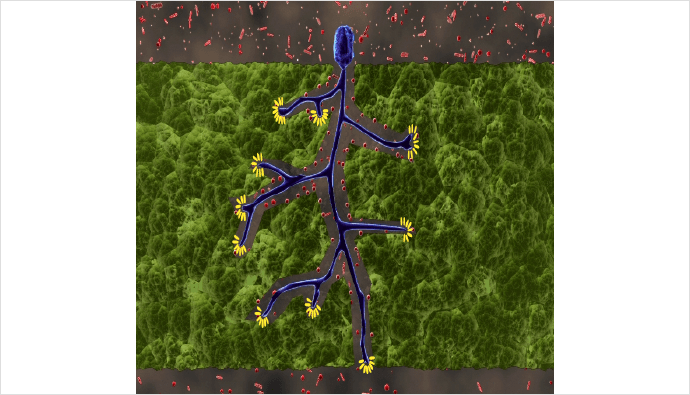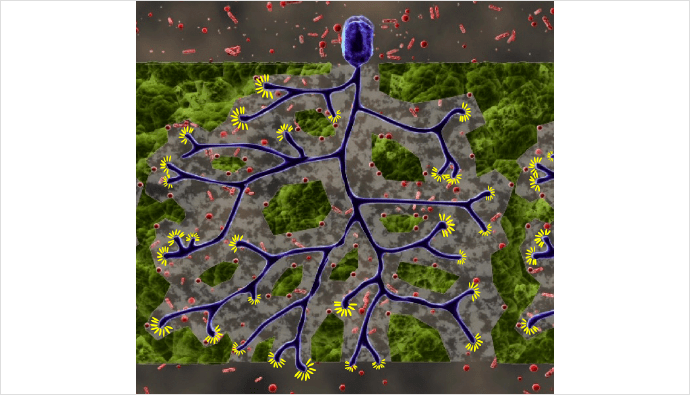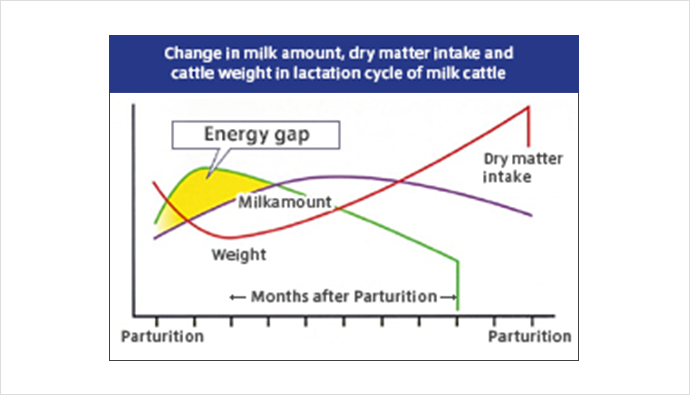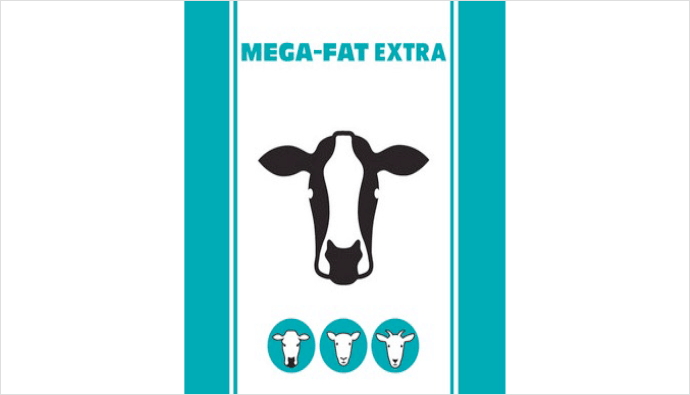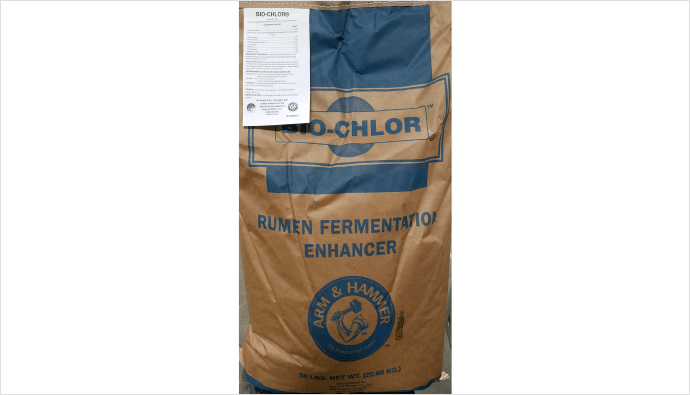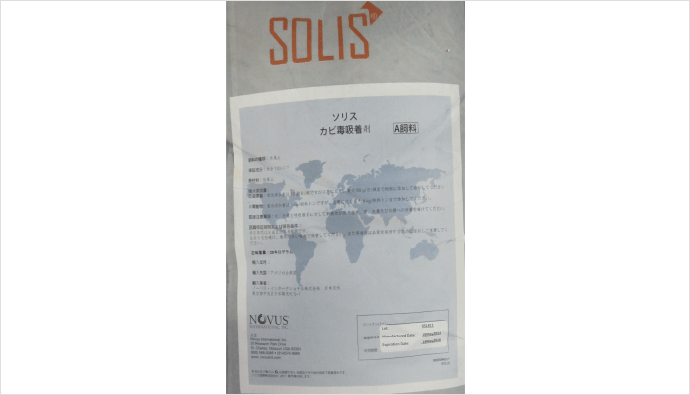Amaferm (Fermented aspergillus oryzae extract)
Amaferm provides feeds for hyphae in the rumen to promote growing the hyphae and decomposing roughage in the rumen. Amaferm is the only product in the world that proved the growth of "fungi" in the rumen. We handle four products, Amaferm bulk, Amaferm MIX, Amaferm PLUS and Amaferm 21.
- Decomposition of roughage in the rumen
(The left picture) - After the Amaferm is supplied
(The right picture) - For those situations
- The roughage is decomposed by bacteria (fiber decomposing bacteria, fungi and others) in the rumen to provide VFA (acetic acid, propionic acid, butyric acid and others).
- The colors show as follows: green in the figure: roughage, blue: fungi, red: fiber decomposing bacteria.
- In the rumen, the fungi (blue) crush the roughage (green) in which the fiber decomposing bacteria (red) penetrate to decompose the roughage even from the inside of the rumen. (The left picture)
- Amaferm grows the hyphae of the fungi (blue) and the fiber decomposing bacteria (red) to promote decomposing the fiber. (The right picture)
- Furthermore, the amount of microorganism-shaped protein increases as the rumen bacteria increase.
- For improvement of rumen environments.
- For improvement of the digestibility.
- For increasing intake in summer.
- For early development of rumens of a calf.
Megalac
Magalac is rumen bypass fats developed for cows. This is also fatty acid calcium made from palm oil. Enables efficient energy supply with high energy values. Increase in the milk yield and the reproductive performance are expected.
- Energy gap
- Risk caused by
the energy gap - For effective energy
supply to lactating cows
- The energy requirement for a dairy cow increases from the close-up period when an embryo begins to rapidly grow.
- While the energy requirement of a dairy cow at the early stage of lactation increases due to the rapid increase in milk production, the feed consumption amount increases gradually, resulting in an energy gap attributable to insufficient energy intake to catch up with the milk production amount.
- The energy deficiency is supplemented by fats stored in the body.
- If the energy gap after parturition is prolonged, fats will be accumulated in the liver, leading to a high risk of fatty liver. If liver function is impaired due to a fatty liver, diseases tend to develop due to metabolism disorder.
- If the energy sufficiency level is low after parturition, the conception rate of daily cows will drop, affecting reproductive performance.
- Megalac contains about three times the energy of corn, which is a typical energy source, and provides an effective energy supply.
- If Megalac is supplied during the period from the close-up period to the peak lactating period, when the energy requirement level is especially high, the following effects are expected: milk production will increase, weight reduction during the early stage of lactation will be prevented and mating/conception rates will increase.
- Excessive feeding of corn, etc., as an energy source increases the risk of acidosis etc. Megalac, however, does not interfere with fermentation in the rumen because it is fatty acid calcium and bypasses the rumen.
ESSENTIOM
ESSENTIOM is rumen bypass fats developed for cows. ESSENTIOM consists of fatty acid calcium made from palm oil and soybean oil. As the product is made from soybean oil, it contains plenty of essential fatty acids (linoleic acid and linolenic acid) that may not be synthesized in the body.
For more improved reproduction
- Linoleic acid/linolenic acid affects growth of follicles and secretion of sex hormones and are related to the hormone pathway essential for conception and maintenance of healthy pregnancy.
- If the substance is supplied, further improvement in reproduction is possible as well as energy supply.
Megafat
Megafat is a saturated fatty acid with 99% or more of palm oil used. The concentration of a palmitic acid (C16:0) attracted attention for measures against milk fat is 95% or more. Please try it as measures against milk fat in summer.
Bio-Chlor
Bio-Chlor is a feed mixture that is supplied to a dairy cow in a close-up period for the negative DCAD control (DCAD value : -3,846 meq/kg). The substance contains plenty of peptide and so can be expected to provide a quality protein source.
Measures for hypocalcium for three weeks
- Supplying Bio-Chlor in prepartum three weeks (close-up period) allows a DCAD value to be negative.
- If the DCAD value turns out to be negative, hormones in blood are stimulated, enabling the introduction of calcium ions smoothly from bones to the postpartum blood if the blood calcium is insufficient after parturition.
- Prepare for hypocalcemia with Bio-Chlor.
* We recommend the feed design for confirmation of the DCAD value.
SOLIS and SOLIS MOS
SOLIS and SOLIS MOS consist of a mineral or a combination of a mineral and a yeast cell wall to serve as a mycotoxin absorber. As the minerals contain sodium montmorillonite it has an excellent swelling property and a small amount of those materials is effective, making it economical. Ion exchange allows those materials to absorb mycotoxin to take it out of the body and discharge sodium ions to be absorbed in the body.
- SOLIS
- SOLIS MOS
- Mold in environments produces hazardous mycotoxin.
- If a dairy cow ingests mycotoxin, it is believed to cause reduction of dry matter intake, reproductive performance and immune systems in the dairy cow.
- As it is hard to decompose mycotoxin, it is commonly absorbed in a mineral absorber and discharged.
- SOLIS features high ion exchange capability and high swelling property, exhibiting high mycotoxin absorption capability even if the amount of the product is small.
- SOLIS MOS is a general mycotoxin prevention feed produced by adding a yeast cell wall to SOLIS.
- A yeast cell wall is rich in β-glucan/mannan oligosaccharide, strengthens immunity and prevents the growth of disease-causing bacteria in the intestinal tract, resulting in reduction of damage caused by mycotoxin.





